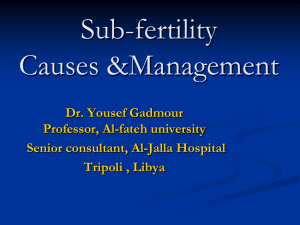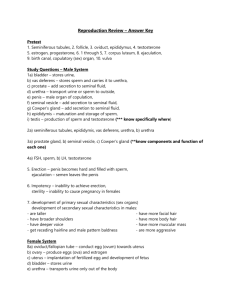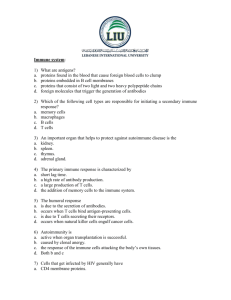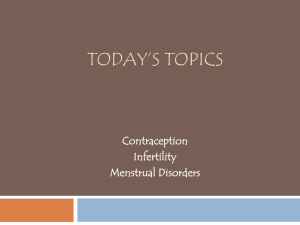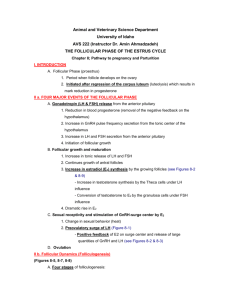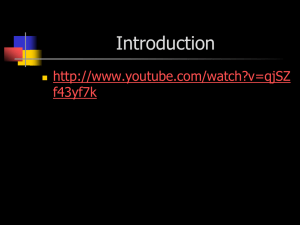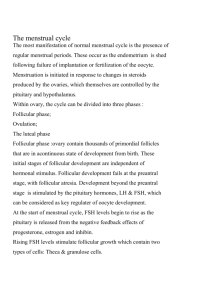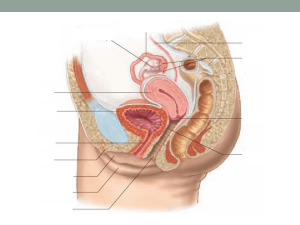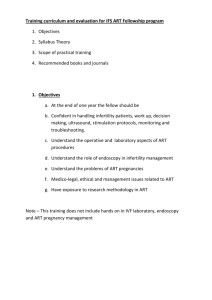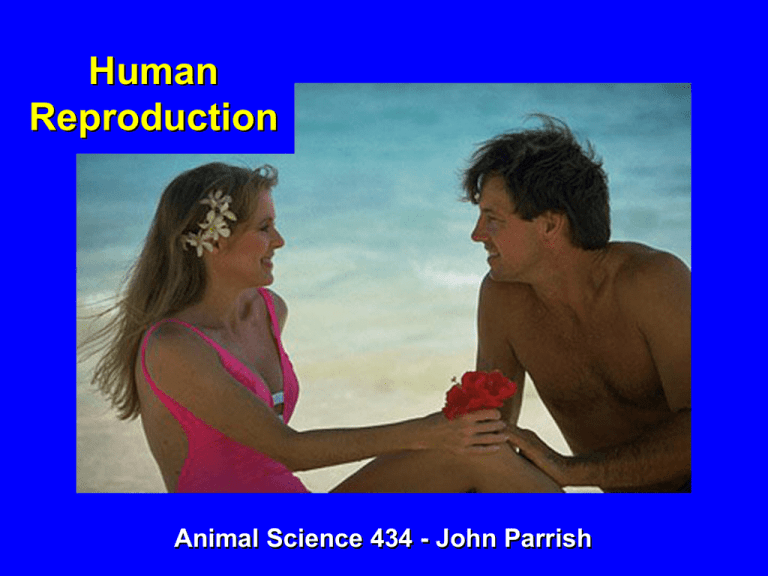
Human
Reproduction
Animal Science 434 - John Parrish
Puberty
Female
» 11 - 12 years
» Influences
– Nutrition
– Economic status
– Trends over last century
Male
» 13 - 14 years
» Influences
– Same as for female
» Trends over the last century
Sexual Behavior
Anatomy
Female
Male
External Genitalia
Lubricates Vagina before and during intercourse
• Source of Pheromones
• Dorm effect
Vaginal Environment
Normally acidic
Changes from medications, douches, lubricants
» Infections
– Yeast
– Bacterial
Cervix
Some think this is a sperm storage site in
human
Sperm survive up to 2 days
Increase in cervical mucous at time of
ovulation
» Response to increased estrogen levels
Uterus
Normal is simplex
Abnormal
» Bicornuate or septae uterus
– Early delivery or spontaneous abortion
– Uterus can not enlarge enough
» duplex
Ovary
400,000 oocytes at birth
Decrease with age
Between 40 - 50 years of age enter menopause
Male Facts
penis is muscular vascular
ejaculate is approx. 3 ml with 200 million
sperm/ml.
ejaculate coagulates upon ejaculation and then
liquifies within 30 minutes
Prostate Gland in Male
Prostate gland hyperplasia
» First growth at puberty
» Second growth starts after age 25
» Urinary symptoms don’t occur before age 40
– 50% of men at 60 have symptoms
– 90% of men at 70 - 80 have symptoms
» Symptoms
– a hesitant, interrupted, weak stream
– urgency and leaking or dribbling
– more frequent urination, especially at night
» Treatment
– 5 alpha reductase inhibitors
– Minimal invasive procedures
– Surgery
Menopause
Begins at 40 - 55 years of age
No follicles left to grow
» No estrogen - causes symptoms
Detection
» Variable menstrual cycles
» Behavior changes and physical changes
» FSH increase
– HMG (human menopausal gonadotropin)
Hormonal Replacement (estrogen and
progesterone)
» Relieves behavioral and physical changes
» Cadiovascular benefits????
» Calcium uptake increases
Andropause
Decreased Testosterone Production
» Reduced response to LH
Age, 48 -70
Physical Changes
» Loss of muscle mass
» Shrinking reproductive organs - penis, testis,
accessory glands
» Loss of libido, increased stimulus needed for
erection, longer refractory period
» Osteoporosis
Mental Changes
» depression
Anterior
Pituitary
Hormones
LH
FSH
Progesterone
Ovarian
Hormones
Estradiol
Follicle
Corpus
Albicans
Ovulation
Corpus Luteum
Ovary
Uterine
Endometrium
Selection
2
4
6
Dominance
8
Recruitment
10 12 14 16 18 20 22 24 26 28
2
Follicle
Ovary
Progesterone
Menses
Estradiol
Luteal Phase
FSH
Menses
Ovarian
Hormones
LH
Follicular Phase
Anterior
Pituitary
Hormones
Ovulation
Corpus Luteum
Uterine
Endometrium
2
4
6
8
10 12 14 16 18 20 22 24 26 28
2
Basal Body Temperature
98.8
Luteal Phase
98.6
98.4
98.2
98
97.8
97.6
97.4
97.2
Luteal Phase
Ovulation
97
1
3
5
7
9
11
13
15
17
19
21
23
25
27
29
31
33
Luteal Phase Remains Constant at 14 days
35
Basal Body Temperature
98.8
98.6
98.4
98.2
98
97.8
97.6
97.4
97.2
97
1
3
5
7
9
11
13
15
17
19
21
23
25
27
29
Abnormal Cycle - No ovulation
31
33
35
Ovulatory Pain
Mittelschmerz (middle pain)
Day 12 - 16 after after start of menstration
Lasts 12 to 36 hours
Cumulative Pregnancy Rate
90
Percentage
80
70
60
50
40
30
20
10
0
1
6
Months
12
Pregnancy
Most prolonged cycles are due to spontaneous
abortion
20% of pregnancies with early pregnancy test
spontaneously abort
Numerous Problems
» Time of intercourse - gamete aging
» Chromosomal abnormalities
Infertility
Common definition
» Primary Infertility
– Failure to conceive within 1 year if no previous
pregnancy
» Secondary infertility
– Failure to conceive within 6 months if at least one
previous normal pregnancy
» Assumption
– Adequate sexual contact or exposure
Adequate Contact or Exposure Problems
Male
» Hypospadias
– Urethra opens on bottom of penis
» Penis size not important unless both male and
female obese. May be a problem in penetration
depth.
Exposure (needed near ovulation)
» Average is 2 to 3 times/week
» Frequency decreases with length of relationship
» Busy schedules
– If intercourse only on weekends, unlikely to
become pregnant
– Delaying pregnancy into 30s increases problems
Age Associated Problems
Male
» Decreased fertility with age, but can occur into 70s
Female
» Rare if over 50
» 10% of women who have conceived can no longer
do so by age 35
» If over 36 and fail to get pregnant within 6 months
should seek evaluation and therapy as time is short.
Misconceptions and Considerations
Coital position
» Does not matter
Laying in bed for 30 minutes
» No scientific merit
Douching after intercourse will not work as a
contraceptive scheme
Birth control pills
» Long term exposure does not effect fertility
» First cycle after going off pill, there is a sight
increase of double ovulations
Adoption - anxiety can effect ovulation
Female Infertility
Failure of follicular development or ovulation
Tubal blockages and ectopic pregnancies
Spontaneous abortion
» Uterine or CL problems
Stimulating Follicular Growth and Ovulation
Low dose estrogen
» Don’t produce enough estrogen for GnRH surge
HCG
» Inadequate LH surge
Clomaphine Citrate - antiestrogen
» Hypothalamus precieves low estrogen so GnRH
increases
» FSH and LH increase stimulating follicular growth
Pergonal (HMG - FSH activity)
» Stimulates more follicular development
Tubal Disease
DES exposure
Infections - blocked oviducts
» Pelvic inflamatory disease
– Chlamydia, Gonorrhea, Strep. and Staph. bacteria,
mycoplasma, tuberculosis
Stop infection, tubual surgery or IVF
»
Ectopic pregnancies
» 1 in 90 - 120
» In DES exposure, 1 in 20
» Dangerous!!!
– Pain
– Spotting or discharge from vagina
Male Infertility
Low sperm count
» Normal 200 million/ml, 2-3 ml
» Abnormal <20 million in ejaculate
– Treatment
Scrotal temperature control
In vitro fertilization (IVF)
Intracytoplasmic Sperm Injection (ICSI)
» Sperm or round spermatid
Abnormal sperm
» Treatment
– Temperature control, IVF, ICSI
Sterilization
Female
» Tubal ligation
Male
» Vasectomy
Reversal are now possible in some cases
Birth Control
Female
» “The Pill” - progesterone + estrogen
» Patches or vaginal Rings
» Long term progesterone
» IUD
» Spermacides
Birth Control
Male
» Condom
» New and in some countries
– Testosterone
– GnRH agonist
– Progesterone + Testosterone
– 5 alpha reductase insensitive testosterone
– Stimulation of premature spermiation
Erythroblastosis Fetalis
Isoimunization of mother with foreign red
blood cell (RBC) antigens
» Human placenta is permeable to some proteins
such as antibodies
» The anti-red blood cell antibody crosses placenta
and destroy fetal RBCs
» RBC antigens
– RH factor
– Other minor RBC antigens
Erythroblastosis Fetalis (cont.)
» Conditions for isoimmunization
– Fetus must have foreign RBC antigen
– Mother must be negative for this antigen
– Fetomaternal hemorrhage occurs at birth or
spontaneous abortion (miscarriage)
From 0.1 to 30 ml of fetal blood enters maternal
circulation
Treatment
» Test at first prenatal visit for Rh antibodies
» If RH negative and Father Rh positive or unkown
– Retest at 28 weeks (don’t see isoimmunization
before this time)
Administer Rh-immune globulin
At birth if fetus Rh-positive also give it Rh-immune
globulin
Sexually Transmitted Diseases
Annual Cases in US (millions)
60
0 00
00
5
4
3
2
1
Curable
50
0 00
00
40
0 00
00
30
0 00
00
20
0 00
00
10
0 00
00
0
Incurable


